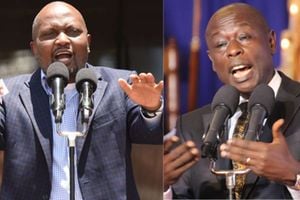Peter Kagwanja: Murang’a lives matter. It’s time to tame Kenya’s violent democracy

Police arrest a man after a meeting at Kandara Technical and Vocational Training College turned chaotic on March 2020.
What you need to know:
- On September 25, chaos and anarchy reigned supreme at a funeral in Nyakahura village in Kangema.
- Conceptually, Murang’a thrust to the fore the vexed debate on violent democracy.
- Violence has become even higher during elections – 1992, 1997 and to a lesser extent, the 2002.
Certainly, Kenya’s democracy is effectively a death-trap. This is exemplified by the deaths at high noon at a church in Kenol, Murang’a, last Sunday. Here, 15-year-old Peter Mbotho and 21-year-old Christopher Kariuki were beaten and stabbed to death as rival political factions in the ruling Jubilee Party fought for the soul of the county ahead of the 2022 election.
Presciently, on September 10, 2020, I was a guest speaker at a meeting convened by the Murang’a Council of Eminent Persons and local elected leaders. In my speech, titled ‘The future of power in Murang’a County: Implications and scenarios for development by 2063’, I identified three possible pathways for the county.
One is a Djibouti scenario – an outpost or client state, where all powers have military camps and whose interests are subordinated to those of external actors. Second, Murang’a could hurtle down the path of Somalia: potentially one of the wealthiest countries in regard to natural resources and one of Africa’s richest and most influential diasporas, but practically the poorest (193rd) globally.
But it could also opt to be a Mauritius – a country in the Indian Ocean that is slightly smaller (2,040 square kilometres) than Murang’a, but with a per capita income many times larger than that of Kenya.
Hooliganism
The speech came against the backdrop of a tragic rise in hooliganism and politically instigated violence as the so-called Tangatanga and Kieleweke goons in Jubilee turned the county into a war zone.
On September 25, chaos and anarchy reigned supreme at a funeral in Nyakahura village in Kangema when politicians turned the solemn occasion of the burial of five relatives who had died in a road accident into a battleground.
In the same month, an armed militia gang terrorised traders and shoppers in Maragua town, leaving two people fighting for their lives at the Maragua Level Four Hospital.
And in March, youths loyal to the two rival Jubilee factions clashed in a meeting and totally disrupted the day’s activities at Kenyoho Secondary School in Kagunduini, Kandara Constituency. As one social media commentator noted, rather forlornly: “It would appear a seed of free market violence is being planted in Mt Kenya region with Murang’a County being the testing ground”.
Conceptually, Murang’a thrust to the fore the vexed debate on violent democracy. Like many other established democracies, Kenya’s democracy is inherently violent. The government must now tame it.
In contrast, response to the 2008 post-election mayhem was propelled by the false belief that democracy is inherently peaceful. This view, itself based on the democratic peace theory that states that countries with liberal democratic forms of government are less likely to go to war with one another, underpinned the push for a new constitution to secure democratic peace.
Violent democracy
But Kenya has continued to reap the whirlwind of its violent democracy. From its origins and into its globalised future, violence is an integral part of the democratic system. While violence and democracy are generally treated as antithetical, beneath the veneer of peace and progress, democracy is violent and destructive from its beginning and at its heart.
However, the concept of violent democracy must be viewed within the wider canvas of particular histories of violence, elite contestations for power and widening inequality.
In Murang’a, politically instigated violence from above is thriving on a long history of extreme poverty, militia violence, alcoholism and drug abuse from below. As of February 2020, the youth unemployment rate in Murang’a stood at 29 per cent, with 80 per cent of the unemployed below the age of 35.
Compounding this situation are the dire economic impacts of the Covid-19 pandemic, which has led to thousands of job losses. The Hustler-Dynasties strategy is tapping deep into the veins of the widening inequality gap.
According to the Economic Survey 2020, released by the Kenya National Bureau of Statistics, Murang’a is among eight counties with the highest number of reported criminal cases in the country, which account for a staggering 41.9 per cent of all crimes reported in the country in the 2019/2020 period.
But the roots of Kenya’s violent democracy are deeper than the current mayhem unleashed by the hustler-dynasties’ class narrative.
Since Kenya returned to multi-party politics in 1991, it has been an abyss of all genres of political violence, which has limited the rights promised by democracy.
Violence has become even higher during elections – 1992, 1997 and to a lesser extent, the 2002. The 2008 post-election mayhem revealed the ugly underbelly of Kenya’s violent democracy in a public and palpable way.
But luckily, democracy has often provided mechanisms for constraining violence. Kenya demands a combination of reassertion of state authority and comprehensive efforts to build national consensus to end orgies of violence of the kind witnessed in Murang’a.
The government directive on October 7 that all public meetings be held in compliance with the Public Order Act is salutary. But the Building Bridges Initiative must now be unfurled to create a new social contract to secure peaceful, orderly and non-corrupt democracy based on devolution of power and resources.





